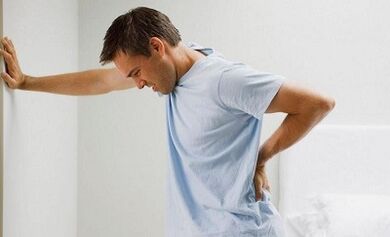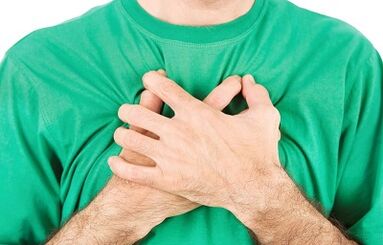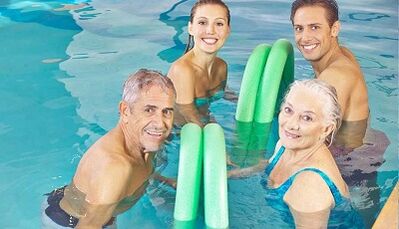
Lumbar osteochondrosis is a chronic back damage that develops in intervertebral discs as a result of many years of physical influences and metabolic disorders.Lumbar osteochondrosis is proven to be the cause of back pain in 75% of cases.
Lumbar column defeat occurs in 60% of the planet's inhabitants - this is the most frequent manifestation of osteochondrosis.The first signs of the disease appear between 20 and 30 years.
The danger of the disease is that the posterior stages of the disease (when a protrusion (protrusion) and intervertebral disc hernias), complications that require surgical intervention, in particular, plantar fascia and a peak are under development.
Lumbar osteochondrosis usually complicates pregnancy.
Causes of Lumbar Osteochondrosis
The main cause of the disease is the systematic load in the lumbar spine and metabolic disorders of the fibrous layer of intervertebral discs.Elevation weights, overweight and constant physical work increase pressure on the vertebrate column.
Other causes of lumbar osteochondrosis: sedentary and sedentary lifestyle, constant use of high heels, malnutrition, consumption of small amounts of liquid, smoking, alcohol abuse.
Quando a estrutura muscular protetora e a ausência de tratamento, o suprimento sanguíneo para os tecidos piora e os processos degenerativos nos discos intervertebrais são piorados.As a result, intervertebral discs do not receive sufficient blood supply - they lose elasticity, "dry", inflamed, flat and salient.
When salient (protrusion), the spinal spine spine is violated, which manifests itself by resting pain and during movements.The posture and incorrect lesions cause an additional unequal load in the spine spine, which accelerates the development of lumbar osteochondrosis.
Osteochondrosis Lumbar Osteochondros
The peculiarity of the disease is the gradual development of degenerative processes.
Neurologists distinguish 4 stages of lumbar osteochondrosis:
- 1st stage& MBSP;Partial inflammation and intervertebral discs.It is manifested by burning in the lumbar and stupid, not intense pain in the lower back.Unpleasant sensations arise after physical effort, weight lifting.
- 2nd stage- The distance between the vertebrae is reduced, changes in the surrounding fibrous ring are determined on the radiography and the disc protrusion occurs.The patient feels acute pain in the lower back, which gives (irradia) to the buttocks and legs.
- 3rd stage- The emergence of intervertebral hernias due to the destruction of the fibrous ring of the vertebrae.In the third stage, cartilage and vertebrae are intensely destroyed.The pain has acquired constant character, they are felt even at rest.
- 4th stage- Atrophy of cartilage and intervertebral discs, accompanied by the pathological growth of the bone tissue of the vertebrae and the formation of osteophytes.Pain occurs with any uncomfortable movement and body position.The pain does not go through its own.These violations require intensive treatment and leads to a severe human disability.
Symptoms of Lumbar Osteochondrosis

In seventy percent of cases, doctors diagnose the disease in the second stage.During this period, the patient observes frequent periods of exacerbation with brilliant symptoms:
- Low pain, which is improved by physical effort.As degenerative processes develop, pain becomes severe and constant;
- Movement restriction.The movements are accompanied by increased pain with irradiation in buttocks and legs;
- Change of sensitivity to the lower ends (tingling, burning, numbness);
- tension of spinal muscles;
- Numbness and calm of the feet.
Diagnosis of lumbar osteochondrosis
In 85% of cases, doctors make a diagnosis using radiography, computed tomography and magnetic resonance imaging (MRI).
The most targeted method is magnetic resonance imaging.With their help, doctors determine the place and degree of damage to the lumbar spine.
The expert's main task is to distinguish osteochondrosis from Bekhterev's disease.
Complications of Lumbar Osteochondrosis
Lumbar radiculitis, or roying syndrome: The pathological process in the spinal nerve (spine) is the most frequent complication of lumbar osteochondrosis.Occurs in 55% of cases.It is accompanied by pain and impaired sensitivity in the lower back and/or along the infringing root.
In the posterior stages of the disease, there is a flat intervertebral disco on the edge of the vertebra - the protrusion.When the fibrous ring is destroyed, an intervertebral hernia is formed.The intervertebral hernia is an occasion to contact a neurosurgeon.
In 40% of patients, the sciatic nerve is inflamed.This causes pain, dormancy of the limb.As a result, the patient tolerates body weight to a healthy leg;The spine is even more curved, which exacerbates the severity of the disease.

10% of patients develop a narrowing of the spine canal, or compression myelopathy - squeezing the spinal cord.Requires surgical treatment.
The rarest but dangerous complication is the “horse tail” syndrome - the defeat of several nearby nerve roots.
Each third patient with this complication has paresis or leg paralysis.It also requires surgical treatment.
Treatment of lumbar osteochondrosis
It is impossible to heal lumbar osteochondrosis.You can remove pain and decrease degenerative processes on vertebrae and discs.80% of success in treatment drops in 1 and 2 stages of the disease.
If there are no complications, neurologists treat lumbar department osteochondrosis with medicines, physical therapy, massage and physical therapy exercises.
Medicines are prescribed for osteochondrosis exacerbations to eliminate inflammation, pain and stimulation of metabolism in vertebrae, cartilage, discs.
In acute pain, the therapeutic effect is achieved by the intramuscular administration of medicines.For local anesthesia, the paravertebral block is prescribed.For 3-6 months, patients receive prescribed chondroprotective.
The purpose of physical therapy exercises is to strengthen the muscle back of the back.Pool exercises are very useful.With lumbar osteochondrosis, the exercises are performed after the elimination of pain.Some doctors prescribe physical therapy exercises, even with pain, however, this should be approached with caution.
Once pain decreases, massage and reflexology courses are recommended.
Uncomplicated lumbar osteochondrosis does not require frequent and multi -dia hospital treatment.The disease is treated at home.They resort to popular remedies whose action comes down to the heating of the lower back.
Prevention of Lumbar Osteochondrosis
For the prevention of lumbar osteochondrosis, follow the simple rules:
- Follow the posture for many hours of stay in a sedentary pose, change the position of the body;
- Swim 3 times a week;
- Raise severity with both hands of a sitting position or, fixing (straightening) the back;
- Avoid drafts;
- For a rest at night, choose an orthopedic mattress.


















